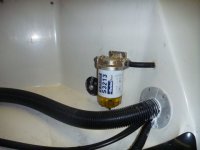My experience with water in the fuel cost me and put me in a dangerous situation. I am passing on to you what I learned so that it does not happen again, to you or me.
I approached the mooring buoy on my stbd fuel tank (good gas), and tied up for an overnight stop. In the morning I switched to port fuel tank (bad gas), started the engines, let go the buoy and puttered out into the main channel. The engines were still running on the good gas in the carbs. When the bad gas kicked in, the engines quit and would not restart.
My big mistake was starting the engines and setting off immediately. Had I started the engines, waited awhile for them to warm up, the problem would have shown itself while I was still tied to the buoy. Lesson learned..........warm those engines up first.
Martin.
I approached the mooring buoy on my stbd fuel tank (good gas), and tied up for an overnight stop. In the morning I switched to port fuel tank (bad gas), started the engines, let go the buoy and puttered out into the main channel. The engines were still running on the good gas in the carbs. When the bad gas kicked in, the engines quit and would not restart.
My big mistake was starting the engines and setting off immediately. Had I started the engines, waited awhile for them to warm up, the problem would have shown itself while I was still tied to the buoy. Lesson learned..........warm those engines up first.
Martin.

